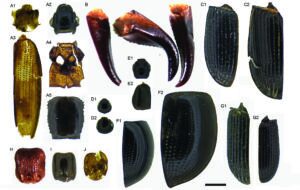
_____________________________

Map of the South Pacific Ocean showing the southern Polynesian islands (brown dashed line) examined in this study (blue boxes). Insets A-C show the study islands, including sediment core locations and high elevation points. Matthew Prebble
_____________________________

Photomicrographs of the invertebrate fossil taxa. B, A1 (head, EA204, 210 cm to 220 cm, early garden), B, A2 (head, RAIDA4, 90 cm to 95 cm, late garden), B, A3 (elytron, EA204, 210 cm to 220 cm, early garden), B, A4 (thorax, EA204, 210 cm to 220 cm, early garden), and B, A5 (prothorax, EA204, 210 cm to 220 cm, early garden) are C. desjardinsi; B, B (forceps, TUKOU2, 58 cm to 60 cm, late garden) is E. annulipes; B, C1 and C2 (elytra, EA204, 170 cm to 180 cm, late garden) are Ataenius cf. picinus; B, D1 and D2 (heads, EA204, 170 cm to 180 cm, late garden) are Aleocharinae spp.; B, E1 (head, EA204, 190 cm to 200 cm, early garden) and B, E2 (pronotum, EA204, 190 cm to 200 cm, early garden) are Carpelimus sp.; B, F1 (elytron, EA204, 80 cm to 90 cm, PEC) is Dactylosternum cf. marginale; B, F2 (elytron, RAIDA4, 100 cm to 105 cm, late garden) is D. abdominale; B, G1 (elytron, EA204, 190 cm to 200 cm, early garden) is Saprosites sp.; B, G2 (elytron, RAIDA4, 50 cm to 55 cm, PEC) is S, pygmaeus; B, H (head, TUKOU2, 74 cm to 76 cm, late garden) is Tetramorium pacificum (Formicidae); B, I (head, EA204, 90 cm to 100 cm PEC) is Hypoponera cf. punctatissima (Formicidae); and B, J (head, RAIDA4, 95 cm to 100 cm, late garden) is Nylanderia sp. (Formicidae). (Scale bar, 0.5 mm.). Nicholas Porch and Matthew Prebble
_____________________________
Article Source: PNAS news release
*”Early tropical crop production in marginal subtropical and temperate Polynesia,” by Matthew J. Prebble et al.




